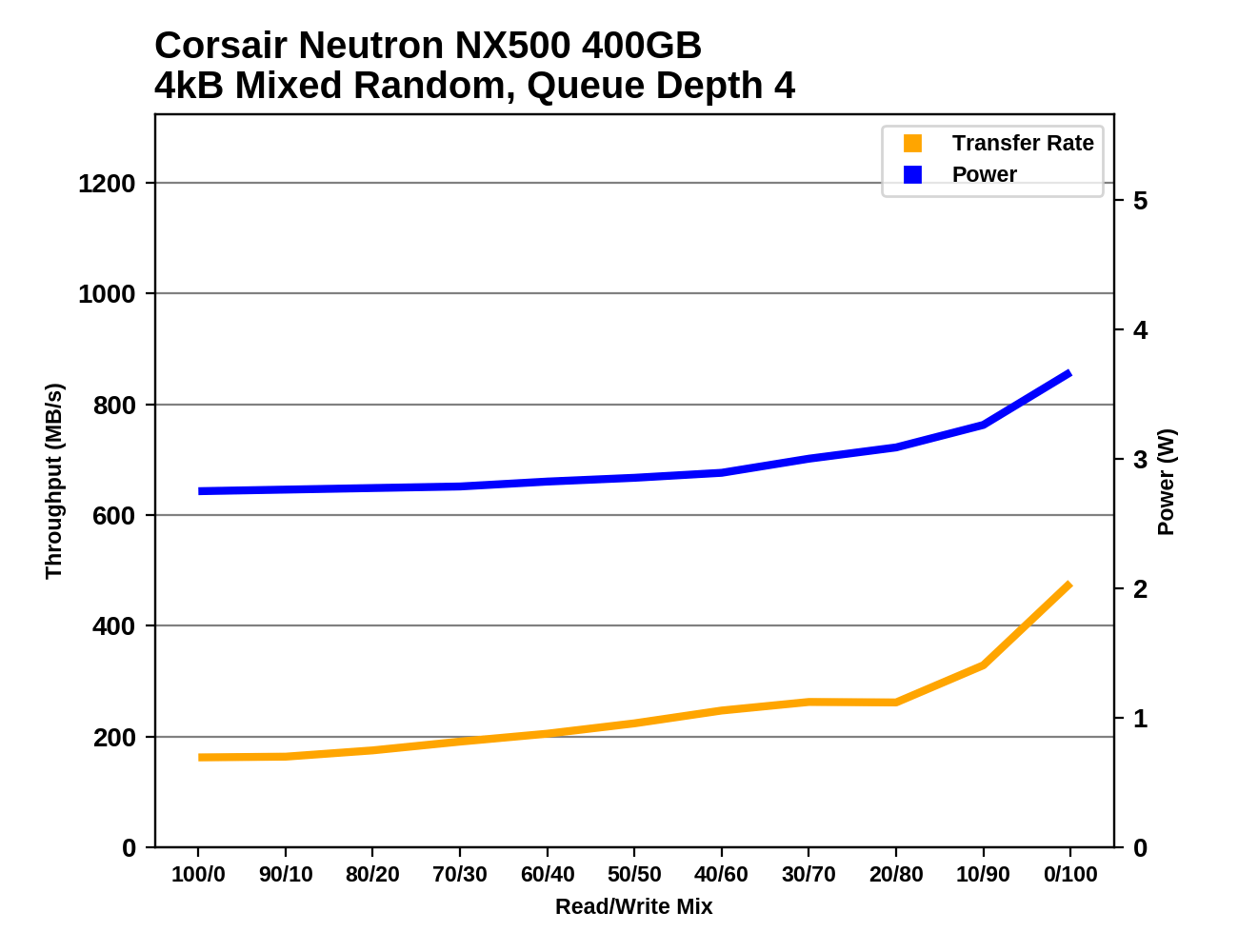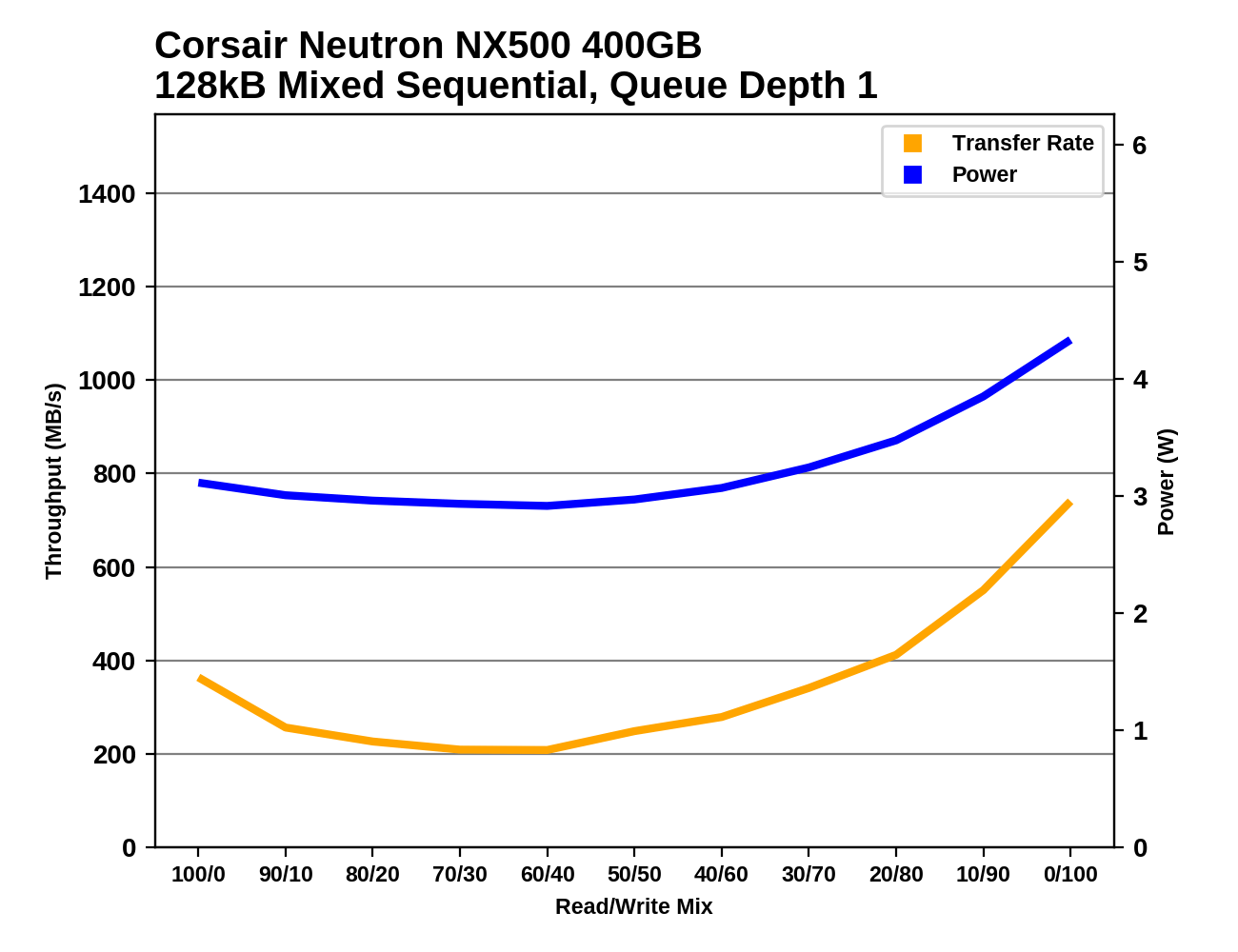The Corsair Neutron NX500 (400GB) PCIe SSD Review: Big Card, Big Pricetag
by Billy Tallis on August 16, 2017 10:00 AM ESTMixed Random Performance
Our test of mixed random reads and writes covers mixes varying from pure reads to pure writes at 10% increments. Each mix is tested for up to 1 minute or 32GB of data transferred. The test is conducted with a queue depth of 4, and is limited to a 64GB span of the drive. In between each mix, the drive is given idle time of up to one minute so that the overall duty cycle is 50%.

The QD4 mixed random I/O performance of the Corsair Neutron NX500 is pretty good overall, but the Patriot Hellfire has a clear advantage. The Zotac SONIX on the other hand can't beat the SATA-based Samsung 850 PRO and is only slightly faster than the Intel 600p.

The power efficiency of the NX500 during the mixed random I/O test is about average, while the faster Patriot Hellfire beating all the other planar NAND SSDs in this bunch.
 |
|||||||||
The performance of the Neutron NX500 increases gradually as the portion of writes increases, not dropping anywhere along the way but also not spiking very high in the final phase of the test where many drives improve greatly.
Mixed Sequential Performance
Our test of mixed sequential reads and writes differs from the mixed random I/O test by performing 128kB sequential accesses rather than 4kB accesses at random locations, and the sequential test is conducted at queue depth 1. The range of mixes tested is the same, and the timing and limits on data transfers are also the same as above.

The mixed sequential performance of the Corsair Neutron NX500 is poor, with it and the Patriot Hellfire performing slightly worse than the SATA-based Samsung 850 PRO and only beating the entry-level TLC NVMe drives. The Zotac SONIX on the other hand performed quite well, though still a bit slower than what the OCZ RD400A manages using the same NAND.

The power efficiency of the NX500 and Patriot Hellfire rank no better than their overall performance on the mixed sequential test, and the Zotac SONIX is only modestly better off.
 |
|||||||||
The NX500's performance on the mixed sequential test bottoms out with 70/30 and 60/40 read/write mixtures, but then shows good improvement as the proportion of writes continues to increase. Most of the MLC drives are able to avoid the performance drop that the NX500 suffers in the early phases of this test, which is what leads to the Zotac SONIX scoring so much better than the NX500.










45 Comments
View All Comments
shabby - Wednesday, August 16, 2017 - link
According to toms review the 500gb one still does 2gb/s read/write at qd1, nothing touches it.Ratman6161 - Wednesday, August 16, 2017 - link
Yes, according to Tom's and others, the 500 GB 960 EVO is still the drive to have in its size class - which is why I bought one. On the other hand the 256 GB 960 EVO doesn't stand up against the competition like the 500 and up drives do. So, when comparing these drives with an eye to actually purchasing one, its a great idea to find reviews of the actual size you are looking at and comparing against other like sized drives.mapesdhs - Thursday, August 17, 2017 - link
Trouble with the EVO is when its cache is full it can't take the heavy writes, and its random & steady state performance are not that great. They're good enough (I bought a 250GB for my brother), but the Pro is way better, and the 950 Pro is better aswell.CrazyElf - Wednesday, August 16, 2017 - link
This doesn't justify the premium over SATA SSDs.Unlike say, the Samsung SSD 960 series or the Intel SSD 750, which do have something to offer, especially when it comes to sequential performance, these drives really struggle to justify the premium.
Yeah it seems increasingly like Intel (SSD 750 dominates sustained writes on 4k) and Samsung (dominates most other benchmarks).
I mean, products like Optane are expensive, but at least they have some premium (ex: the good 4k performance).
versesuvius - Wednesday, August 16, 2017 - link
Corsair expects to be paid higher for whatever it puts together no matter what. The same is true with Cooler Master and Logitech. For each single one of their products there is an equivalent product on the market that is higher in quality and performance and considerably lower in price.valinor89 - Wednesday, August 16, 2017 - link
I don't know about Cooler Master, but logitech sells plenty of cheap stuff and some products have very good prices for what they offer. The G502 was quite the revolution in perf/price and I find my G610 to have very good quality compared to Corsais Oferings.Bullwinkle J Moose - Wednesday, August 16, 2017 - link
With PCIe lane counts coming up, I hope to see Samsung and Intel start using themWith a full 16 lanes being used, benchmarking can finally change along with the SSD processors/firmware
Intel may take the lead with xpoint initially, but with the ability to run several simultaneous tests on an SSD max iop / mixed mode, copy/paste, 100GB uncompressed read speed, 100GB uncompressed write as well as torture tests as the onboard processors finally catch up to the lane counts, I think Samsung may yet have a few surprises for xpoint
4 lanes ain't gonna cut it for my 16 core cpu
Get with the times!
Ratman6161 - Wednesday, August 16, 2017 - link
No matter how many PCIe lanes your ThreadRipper CPU has available (assume that's what you are talking about since you say 16 core) the spec for NVMe is still x4Billy Tallis - Wednesday, August 16, 2017 - link
NVMe has nothing to say about PCIe lane counts. You're probably thinking about the M.2 connector, but that is hardly the only way to connect a PCIe SSD.hlm - Wednesday, August 16, 2017 - link
Yes, it is when NVMe is used through U.2 and M.2 that you get four-lane PCIe. When used through SATA Express, NVMe is stuck with two-lane PCIe.